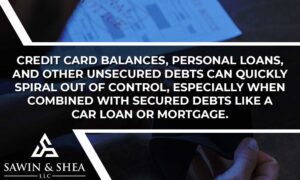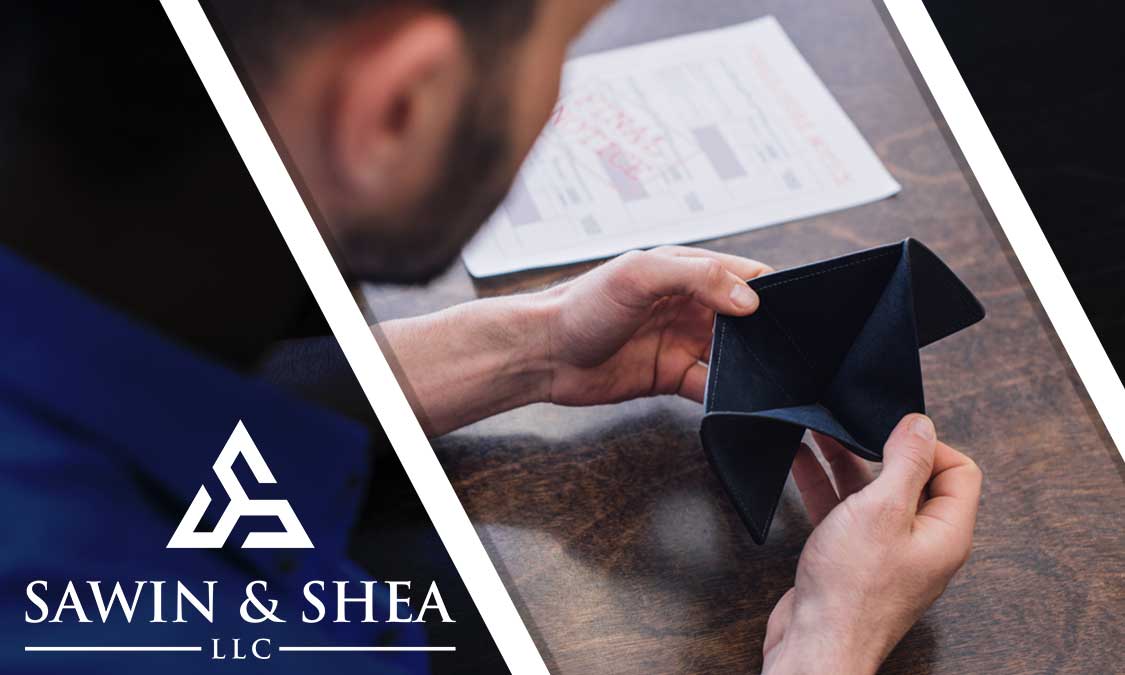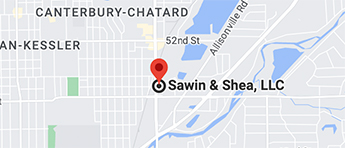If you’re struggling with overwhelming debt, you may be wondering if bankruptcy is the right solution for your financial situation. One of the most common questions people have is “How Much Debt is Needed to File for Bankruptcy?”

The truth is, there is no set minimum debt amount required to file for bankruptcy protection. However, that doesn’t mean bankruptcy is the best option for everyone with debt. Before taking the step toward filing for bankruptcy, it’s crucial to know all your debts, understand your specific circumstances, the types of debt you have, and whether bankruptcy can provide the fresh start you need.
In this comprehensive guide, we’ll explore when filing for bankruptcy makes sense, how to determine if you qualify, the obligations that can be discharged, and the pros and cons of the different bankruptcy chapters.
Sawin & Shea, LLC: Your Trusted Guide to Financial Freedom Through Bankruptcy
If you’re a resident of Indiana struggling with overwhelming debt, the thought of filing for bankruptcy may have crossed your mind. While the process can seem daunting, partnering with the right legal team can make all the difference in navigating the complexities of the law and securing the fresh start you deserve. Enter Sawin & Shea, LLC – a firm with over 50 years of combined experience in bankruptcy services, dedicated to providing compassionate and non-judgmental representation to individuals and families in need.
At Sawin & Shea, LLC, our team of seasoned attorneys understands the weight of financial stress and the toll it can take on your well-being. With a deep commitment to personalized service, we take the time to understand your unique circumstances and tailor our approach to your specific needs. Whether you’re facing foreclosure, repossession, wage garnishments, or relentless creditor harassment, our expertise in bankruptcy law can offer the protection and relief you’ve been seeking.
One of our firm’s key strengths lies in our comprehensive understanding of both Chapter 7 and Chapter 13 bankruptcy options. If you qualify for Chapter 7 bankruptcy, our attorneys can guide you through the process of eliminating unsecured debts, such as credit card balances, medical expenses, and personal loans, within a matter of months. This powerful solution can immediately halt creditor harassment, wage garnishments, and lawsuits, allowing you to breathe a sigh of relief and regain control of your financial life.
What sets Sawin & Shea, LLC apart is our commitment to clear communication and accessibility. Our attorneys take the time to explain the bankruptcy process in a straightforward manner, ensuring you understand your rights and obligations every step of the way. We offer evening and weekend appointment options to accommodate your busy schedule, and our flexible payment plans make our services accessible to those in financial distress.
With a team of seasoned attorneys, you can trust that your bankruptcy case is in capable hands. If the weight of debt has become too heavy to bear, don’t hesitate to take the first step towards financial freedom. Contact Sawin & Shea, LLC today for a risk-free consultation and let our team of dedicated professionals guide you through the bankruptcy process with compassion, expertise, and a commitment to securing the best possible outcome for your unique situation.
When You Have Too Much Debt to Handle

Sometimes debt can pile up to the point where making even minimum payments feels impossible with your current income. Credit card balances, personal loans, and other unsecured debts can quickly spiral out of control, especially when combined with secured debts like a car loan or mortgage. A high interest rate makes it even harder to make progress paying down balances.
If you find yourself missing payments and looking to borrow money due to so much debt compared to your gross income, bankruptcy may be an option to regain your financial footing. Bankruptcy filers with income below their state’s median can potentially qualify for Chapter 7 to discharge many debts. However, certain debts like child support, alimony, and other domestic support obligations cannot be eliminated. Student loans are also difficult but not impossible to discharge in bankruptcy.
For wage earners with regular income above the median, Chapter 13 bankruptcy allows you to consolidate payments through a court-approved wage earner’s plan. Rather than settlements or minimum payments to each creditor, a single payroll deduction is made to fund your plan over 3-5 years.
Bankruptcy Law Provides a Fresh Start
While bankruptcy brings a negative mark on your credit report for up to ten years, it allows you to get out from under crushing debt you simply can’t repay. By filing for bankruptcy and receiving a discharge, you can prevent garnishments, foreclosure, vehicle repossession, and harassment from creditors and debt collectors.
Bankruptcy law was created to give debtors a true fresh start and pathway to rebuilding wealth. After bankruptcy, you can obtain new credit through a secured credit card or borrow more money through other means without old obligations weighing you down.
Just be sure to hire an experienced bankruptcy lawyer to correctly file all the required paperwork with the courts and properly list all assets, your bank account, and creditors. Bankruptcy legal fees are an investment in finally resolving your debt for good.
How Much Debt Is Enough? Do You Have Enough Dischargeable Debt to File Bankruptcy?
While there is no minimum debt amount for filing for bankruptcy, you’ll want to make sure you have enough dischargeable debt to make filing worthwhile. Dischargeable debts are those that can be eliminated through bankruptcy.
Some common dischargeable unsecured debts include:
- Credit card debt
- Personal loans
- Medical bills
- Utility bills
- Certain types of obligations without collateral
However, all your debts cannot be discharged, even when you file bankruptcy.
These non-dischargeable debts include:
- Most student loans
- Child support and alimony obligations
- Most tax debts
- Court fees, fines, and penalties
- Obligations from personal injury cases involving DUI
If the majority of your debt burden consists of non-dischargeable obligations like student loans or tax debt, bankruptcy may not provide significant debt relief. Take a close look at your debt breakdown to determine if you have enough tax debts and other obligations to make filing worthwhile.
The Bankruptcy Means Test
Even if you have considerable dischargeable debt, you’ll still need to pass the bankruptcy means test to qualify for Chapter 7 bankruptcy, which is a liquidation of assets to pay off creditors.
The means test compares your current monthly income to the median income for a household of your size in your state. If your income exceeds the median, you may not be eligible for Chapter 7 bankruptcy unless you can demonstrate special circumstances that would allow your filing.
For example, in Indiana, the current median annual income is:
- 1-person household: $60,351
- 2-person household: $77,580
- 3-person household: $91,461
- 4-person household: $105,581
If your household income is higher than the median for your household size, you may still be able to file Chapter 7 bankruptcy if you can pass the full means test calculation that factors in certain allowed expense deductions from your income.
Those who don’t pass the test according to bankruptcy laws are still eligible for Chapter 13 bankruptcy, which involves a court-approved debt repayment plan rather than liquidation.
Secured Debt vs. Unsecured Debt
Not all debts are treated equally in bankruptcy court. It’s critical to understand the difference between secured and unsecured debts according to bankruptcy code.
Secured obligations have collateral attached, such as a mortgage secured by your home or an auto loan secured by your vehicle. With secured debts, your creditors have the right to seize the collateral property if you default on payments.
In contrast, unsecured debt from unsecured creditors doesn’t have collateral attached. Credit card balances, personal loans, medical bills, and utility bills are generally unsecured debt.
Both secured and unsecured debts can typically be discharged in bankruptcy. However, handling secured obligations requires some additional considerations:
Chapter 7 Bankruptcy and Secured Debts
In Chapter 7 liquidation bankruptcy, you have three main options for dealing with secured debt:
1) Surrender the collateral back to the lender to discharge the debt
2) Reaffirm the debt by agreeing to remain obligated to the original contract terms
3) In some cases, you may be able to “redeem” the collateral by paying the creditor a lump sum equal to the current value
With mortgages and auto loans, many debtors choose to reaffirm and keep the collateral by continuing the monthly payments. Surrendering the home or vehicle can eliminate the debt but also means giving up the property.
Chapter 13 Bankruptcy and Secured Debts
With a Chapter 13 repayment plan bankruptcy, you can often keep secured assets like homes and vehicles while catching up on past-due payments over a 3-5 year repayment period.
By reorganizing secured debts and financial obligations into your repayment plan, Chapter 13 stops foreclosure or repossession, buys you time to get current, and may even allow you to cram down certain debts to lower minimum payments.
When Bankruptcy Makes Sense
In some situations, bankruptcy provides much more powerful debt relief than any alternative.
Here are some cases where filing makes the most sense:
- You have little or no assets to protect, and your debts exceed your ability to repay through other means like debt consolidation.
- When the assets you have are in danger from creditor action.
- Your major debts are dischargeable, such as credit cards, medical bills, personal loans, or payday loans.
- You missed your minimum amount of mortgage or auto payments, and Chapter 13 would allow you to keep the collateral while catching up over time.
- You are stuck in a cycle of barely making minimum payments on debt.
- You are facing lawsuits and judgements.
- Repossessions are pending.
If you’re facing harassment from aggressive debt collectors, considering bankruptcy may be wise simply to get the benefit of the automatic stay that stops creditor actions.
If your disposable income could support a Chapter 13 repayment structure, that option avoids liquidating assets in Chapter 7 bankruptcy. But if your income is below-median and Chapter 7 bankruptcy is a possibility, it may provide the quickest path to a true fresh start.
The Bankruptcy Filing Process
The bankruptcy process begins by having you provide documents and information needed to your attorney so that they can prepare a bankruptcy petition and schedules. You will then complete the required credit counseling from an approved agency.
Your bankruptcy lawyer will work with you to complete detailed bankruptcy forms that disclose all assets, income, expenses, debts, and creditor information. These forms are filed electronically with the bankruptcy court.
According to the bankruptcy code, next you’ll attend a mandatory 341 meeting of creditors where you are sworn in and questioned by the bankruptcy trustee assigned to your case. The case trustee will examine the paperwork and ask questions to verify details about your assets, income, and debts.
Provided no issues arise at the 341 meeting:
- In a Chapter 7 bankruptcy case, the trustee will take control of any nonexempt assets to liquidate for creditor payouts. You’ll receive your discharge order within 60-75 days.
- In Chapter 13, your proposed 3-5 year repayment plan will go before the bankruptcy judge for confirmation. Upon completing all plan payments and meeting remaining obligations, you’ll receive your Chapter 13 debt discharge order from the court.
While a bankruptcy discharge eliminates your personal liability for the included debts, be aware that it will remain on your credit report for 7-10 years and impact your ability to obtain new credit for a period of time.
The Automatic Stay Provides Relief
One of the immediate benefits of filing bankruptcy is that it imposes an automatic stay. The automatic stay is a federal injunction that stops most creditor actions to collect debts from the moment your bankruptcy case is filed.
Specifically, the stay prohibits creditors from:
- Initiating or continuing any lawsuits
- Demanding payments from the debtor
- Sending letters or making collection calls
- Garnishing wages
- Foreclosing on mortgages or repossessing vehicles
- Shutting off utilities
This provides immediate relief from creditor harassment and legal actions. As long as the stay is in effect, creditors are banned from continuing collection efforts on debts that may potentially be discharged in your bankruptcy.
The automatic stay gives you some breathing room to get your finances in order. It also preserves your assets and income so they can be properly addressed during the bankruptcy process, rather than having them seized by aggressive creditors beforehand.
Making the Right Choice for Your Financial Future
As you can see, there is no universal minimum debt amount required to file for bankruptcy protection. The decision depends far more on your overall financial situation, disposable income, assets, income level, and the types of debts you’re facing.
For some, bankruptcy – whether Chapter 7 or Chapter 13 – is clearly the best path to resolving unmanageable debt and getting a true fresh start. For others, less drastic options like consolidation or debt settlement may allow for repayment without the negative credit impact of bankruptcy.
The key is making an informed choice based on your unique circumstances. Consulting with an experienced bankruptcy lawyer is the best way to understand all of your options and take the smartest next steps for your short-term relief and long-term financial health.
If bankruptcy makes sense for your situation, a qualified bankruptcy lawyer can guide you through every step of the filing process, from credit counseling to the meeting of creditors to your final discharge order. While it’s not an easy decision, bankruptcy was created to give good people an opportunity to recover from crushing debt and rebuild their lives.
Don’t let overwhelming debt drag you down when there are legal solutions available. Take control of your finances once again by exploring all of your debt relief options, including Chapter 7 bankruptcy and Chapter 13 bankruptcy protection in bankruptcy court. The path to becoming debt-free could be closer than you think.
Contact Sawin & Shea, LLC
If you are struggling with overwhelming debt and considering bankruptcy as a potential solution, don’t hesitate to take action. The team at Sawin & Shea, LLC has extensive experience guiding clients through filing bankruptcy. We know how much debt is too much debt and can help you explore all available options to find the best path forward. Don’t let unmanageable debt continue to weigh you down – contact Sawin & Shea today to schedule a free consultation to discuss attorney fees and take the first step towards your bankruptcy filing and financial freedom.
If you’re considering filing Chapter 7 bankruptcy or are going through the process, it’s important to remember that you don’t have to go through the steps alone. Bankruptcy is the best financial option for many struggling with debt, and it may be the right tool to get your finances back on track, rebuild credit, and on the road to homeownership.
Take control of your finances and learn all about bankruptcy basics by calling the Sawin & Shea administrative office at 317-759-1483 or visiting us online to schedule your free bankruptcy consultation today.



